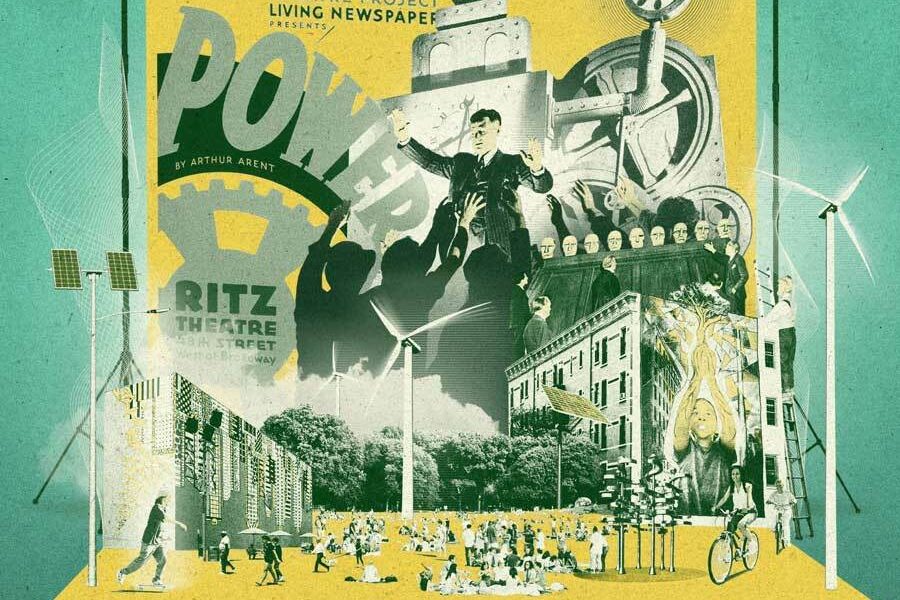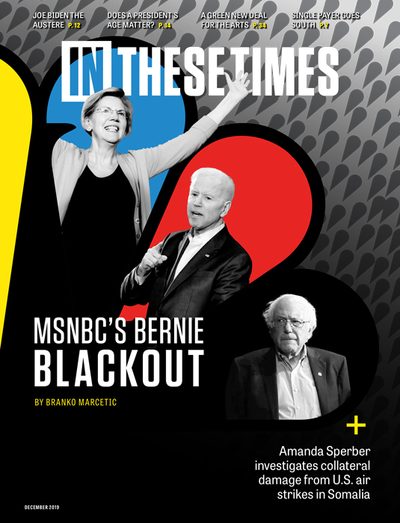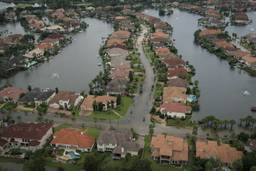The New Deal Funded the Arts. The Green New Deal Should, Too.
Cultural work has a key role to play in shaping the climate-friendly economy.
Ashley Dawson

Near the end of his first term, as effects of the Depression lingered, President Franklin D. Roosevelt faced growing popular clamor for dramatic economic action. In response, he launched a series of initiatives in 1935 that historians dub the Second New Deal. Among these audacious programs were the Social Security Act, the National Labor Relations Act and the Works Progress Administration (WPA), which provided jobs for more than 8.5 million unemployed Americans. WPA workers built crucial infrastructure around the country, including the start of the federal highway system and hundreds of thousands of public buildings, parks and playgrounds.
The WPA also had a cultural wing that supported writers documenting the nation’s folklore (including the stories of elderly freed slaves), artists creating murals and statues for new public buildings, and playwrights and theater workers staging inexpensive performances across the country. WPA organizations like the Federal Writers’ Project and the Federal Theatre Project (FTP) brought art to the people and provided jobs for unemployed cultural workers— all while shining the spotlight on pressing political issues. The Green New Deal should learn from this: A federal Green Arts Project could help lift up radical solutions to corporate malfeasance in our own time, while creating huge numbers of low-carbon jobs.
In 1936, roughly 27 million Americans lived on farms, largely without electricity. As the science writer Waldemar Kaempffert argued in a New York Times editorial that year, electrification was a critical challenge for the United States, whose relatively weak federal government prevented it from launching the kind of nation-spanning modernization projects initiated by the Soviet Union and Nazi Germany.
This challenge underlined the inequities and dysfunctions of the United States’ capitalist economy. As Kaempffert explained, “Power companies are not philanthropic institutions. Investors look to them for dividends. If there is no market in a sparsely populated territory it is ruinous to electrify it, and this because it costs 10 times as much to distribute as to generate energy.” The logic of the market, in other words, not only acted against the public interest, but excluded a significant segment of the public — in particular, rural residents — from access to key infrastructure. As Kaempffert argued, “The profit motive must be subordinated to the obvious social duty of spreading the use of electricity.”
It was in this context that, in 1937, the Living Newspaper unit of the FTP debuted the play Power in New York City. Billed as “a thrilling dramatization of modern industry,” Power presented details of the corrupt dealings of the nation’s private, investor-owned electric utilities, such as rampant price fixing and other methods of gouging the public. Power challenged corporate control and corruption in media in two ways: on stage — showing how the big utilities bought off academics and newspapers to discredit the idea of publicly provided electricity — and off — by giving artists a space to produce critical accounts of timely social and political issues.
Power remains all too relevant. The nation’s dominant electric utilities are still in private hands, gouging ratepayers around the country. Worse still, saddled with massive fossil fuel assets, these monopolistic corporations are one of the major obstacles to a transition to renewable energy. Electric utilities largely rely on coal and natural gas and spend billions lobbying Congress in their interest.
The second half of Power documents the struggle to establish the Tennessee Valley Authority (TVA), the public entity that electrified much of the rural South. At the time Power was produced, the utilities were fighting TVA in the Supreme Court, but the FTP did not shy away from controversy; it was defined by its daring interventions. Under the direction of the pioneering female theater director and writer Hallie Flanagan, the FTP’s Living Newspaper unit assembled a team of journalists to gather factual information about an issue of public concern, then distributed the research to editors and writers to create narratives. The FTP’s focus on public power — in both senses — offers a suggestive model for today.
The Green New Deal, as outlined by Rep. Alexandria Ocasio-Cortez (D-N.Y.) and others, is self-evidently about transforming the country’s infrastructure. But like the New Deal, it also needs a cultural wing. The Green New Deal must, at bottom, be about changing people’s minds: about where power should come from and who has the right to generate it; about what a just transition for workers and affected communities should look like; about what constitutes a good life. While much has changed in U.S. culture since the 1930s, the corporate media is still failing to host these important conversations. When even supposedly enlightened companies like Google are contributing to climate change-denying think tanks, the public needs a space for media in the general interest.
We all know that a Green New Deal would involve massive public works: transforming the electrical grid to renewable energy; electrifying transportation; decarbonizing manufacturing; building millions of zero-carbon public buildings and social housing units; retrofitting existing buildings for efficiency and electrified heating and cooling; and totally revamping the country’s agricultural sector. All this will generate hundreds of thousands of wellpaying jobs that could lift entire communities out of economic and social oppression.
A federal Green Arts Project could boost such projects, too, by explaining the necessity and attractiveness of infrastructure like high-speed rail and zero-carbon social housing, using artforms that speak to the public more effectively than data ever could. Such a Green Arts Project could help dramatize the need for a just transition, one that attends to and rectifies the unevenness of environmental impacts.
The Green New Deal cannot just be about building more stuff. In fact, a crucial element of the Green New Deal must be figuring out how to consume much less without spurring mass unemployment. Capitalism as an economic system is inherently driven to grow or face crisis, which explains why CEOs sit around boardrooms figuring out how to get people to buy more Whoppers, 15-foot Rudolph-the-reindeer inflatables and Return of the Jedi wall clocks — wonders of consumer culture that make us sick and contribute to the destruction of ecosystems like the Amazon rainforest. All this economic growth has meant feeding more and more of the planet into the insatiable maw of capitalism. In the period from 1970 to 2017, as inequality skyrocketed, the global extraction of natural resources increased more than 240%. In 2017, the world extracted a staggering 92 billion tons of material stuff, from construction materials to metals to fossil fuels to food. The Global Footprint Network estimates that resource use overshoots, by more than 70% annually, what can be sustainably maintained.
While we should strive to increase our economic efficiency, the evidence shows that more growth inherently means more carbon emissions, and more extraction writ large. We ultimately must scale down global economic activity if we intend to avoid climate chaos, and build up new, low-extraction industries to avoid galloping unemployment. What we need is jobs that don’t involve working endlessly to make more useless stuff; instead, the Green New Deal should pay handsomely and connect people with one another. Building up the so-called social economy could include cooperative institutions for childcare, elder care, education and other services. It must also include cultural work.
The arts can be a low-extraction sector of the economy, and a Green Arts Project would clearly seek to support low-budget, minimal-impact ventures akin to the Federal Theatre Project rather than blockbuster Hollywood cinema. As with the FTP, the content of local productions could be tailored to local circumstances, allowing masses of people to consume relevant cultural productions without consuming lots of resources. And, as the model of Power suggests, a federal Green Arts Project could also allow writers and artists to catalyze important debates about corporate monopolies and the limits of economic growth.
Power could easily be updated for a contemporary audience. But in addition to such muckraking, a Green Theater Project might provide a forum to debate vexing questions about what public energy ought to look like: local and decentralized, largescale and federally run, or some combination? And how do we ensure that the energy transition is as just and democratic as possible?
There are obviously many complex technical issues behind these questions, about which members of the public need to be educated. But the challenge of creating renewable public power is ultimately a political, and even cultural, one. The American public needs new stories, ones that challenge dominant Hollywood narratives that suggest the climate crisis will inevitably devolve into a Hobbesian war of all against all. In place of such box office nihilism, we need visions of human empathy and solidarity in the face of ecological chaos. We need hope for a damaged people and planet. And to give it to us, we need an Arts Project for the Green New Deal.








